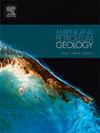跨越侏罗纪-白垩纪边界和早白垩世时期的 3000 万年轨道影响沉积作用
IF 3.7
2区 地球科学
Q1 GEOSCIENCES, MULTIDISCIPLINARY
引用次数: 0
摘要
从位于青岛西南东亚的灵山岛科学钻孔 1(LS-1)中获取了从早白垩世到晚侏罗世的连续沉积演替。对数据中不同区间的频谱分析揭示了从米级到分米级的周期层次。几个地层单元的周期比为 20:5:2:1,分别对应于 405 千年(长轨道偏心)、100 千年(短轨道偏心)、40 千年(斜距)和 20 千年(前距)的米兰科维奇周期,表明沉积受天文控制。根据对磁感应强度、铀和伽马射线地层系列的解释,建立了一个长达 405 千年的轨道偏心周期,其持续时间为 30 万年。浮动天文时间尺度为地层边界和地质事件提供了数值年龄,是海洋和陆地系统之间地层和事件相关性的基础。灵山岛露头的 K1l(早白垩世莱阳地层)-K1q(早白垩世青山地层)界线的 U-Pb 测定年龄为 125 Ma,这一年代相当不精确。锚定时间尺度将侏罗纪/白垩纪(J-K)界线的位置定在 677-674 米(∼144.6Ma)处。侏罗纪/白垩纪(J/K)边界的普贝克海相倒退影响了 J/K 边界附近的米兰科维奇信号。在代用时间序列的功率谱中可以观察到周期为 11-Myr 的明显谱峰,表明可能存在构造印迹。这个 11-Myr 周期可能是由于中生代晚期古太平洋板块在欧亚大陆下的俯冲作用造成的,在这里调查的 30-Ma 沉积记录中记录了这一过程。11-Myr构造周期与2.4-Myr轨道偏心周期之间的相互作用似乎共同控制着沉积速率和环境的变化。本文章由计算机程序翻译,如有差异,请以英文原文为准。
30 million years of orbitally influenced sedimentation across the Jurassic—Cretaceous boundary and Early Cretaceous period
A continuous sedimentary succession spanning the Early Cretaceous through the Latest Jurassic was retrieved from the Lingshan Island Scientific Borehole 1 (LS-1), located on Eastern Asia southwest of Qingdao. Spectral analysis of different intervals in the data reveals a hierarchy of meter-to decameter-scale cyclicity. The ratios of the cycles in several stratigraphic units are ∼20:5:2:1, corresponding to those of Milankovitch cycle periods of 405 kyr (long orbital eccentricity), 100 kyr (short orbital eccentricity), 40 kyr (obliquity), and 20 kyr (precession), indicating astronomical control on sedimentation. From interpreted 405 kyr long orbital eccentricity cycles along the magnetic susceptibility, uranium, and gamma ray stratigraphic series, a floating astronomical time scale with a duration of ∼30 Myr is established. This ATS provides numerical ages for stratigraphic boundaries and geological events, and serves as the basis for correlation of strata and events between marine and terrestrial systems. The ATS is anchored to a rather imprecise U-Pb determined age of 125 Ma for the K1l (Laiyang Formation of Early Cretaceous)-K1q (Qingshan Formation of Early Cretaceous) boundary from the Lingshan Island outcrops. The anchored time scale places the location of the Jurassic/Cretaceous (J-K) boundary at 677-674 m (∼144.6 Ma). The Purbeckian marine regression at the J/K boundary impacts the Milankovitch signals around the J/K boundary. Distinct spectral peaks with periods of ∼11-Myr are observed in the power spectra of the proxy time series, indicating a possible tectonic imprint. This ∼11-Myr cycle may be attributed to the subduction of the paleo-Pacific plate under Eurasia during the Late Mesozoic, which is being recorded in the ∼30 Ma here investigated sedimentary record. The interplay between the ∼11-Myr tectonic cycle and the ∼2.4-Myr orbital eccentricity cycle appears to jointly control the variation in depositional rates and environments.
求助全文
通过发布文献求助,成功后即可免费获取论文全文。
去求助
来源期刊

Marine and Petroleum Geology
地学-地球科学综合
CiteScore
8.80
自引率
14.30%
发文量
475
审稿时长
63 days
期刊介绍:
Marine and Petroleum Geology is the pre-eminent international forum for the exchange of multidisciplinary concepts, interpretations and techniques for all concerned with marine and petroleum geology in industry, government and academia. Rapid bimonthly publication allows early communications of papers or short communications to the geoscience community.
Marine and Petroleum Geology is essential reading for geologists, geophysicists and explorationists in industry, government and academia working in the following areas: marine geology; basin analysis and evaluation; organic geochemistry; reserve/resource estimation; seismic stratigraphy; thermal models of basic evolution; sedimentary geology; continental margins; geophysical interpretation; structural geology/tectonics; formation evaluation techniques; well logging.
 求助内容:
求助内容: 应助结果提醒方式:
应助结果提醒方式:


